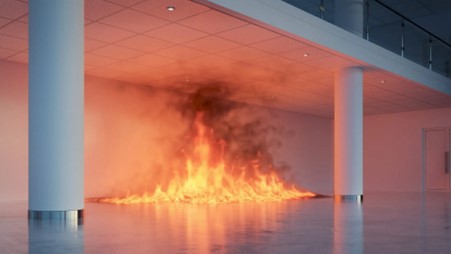Extinguishing The Myths Around Fire-Rated Ceilings
Extinguishing The Myths Around Fire-Rated Ceilings.

In today’s fast-changing building environment, a ceiling has become a feature that is often only looked at during the final frantic phase of the project.
The phrase “fire-rated ceiling” has become a generic description used by professionals, but in reality, is not common to achieve locally. For a ceiling system to be fire rated, there must have been a complete system test performed at an accredited laboratory - within a specified time period and with a test report available to substantiate the claim. All the components tested should also be non-combustible, but non-combustibility should not be confused with fire-rated.
Even more confusing is when a “fire-rated ceiling grid” is specified, there is simply no such thing as the whole system is evaluated. Additionally, when a system is tested, there are two distinct performance criteria: Stability & Integrity and Insulation.
Stability & Integrity
The intention of a fire-rated ceiling system with an exposed ceiling grid is to provide some time for occupants to evacuate an area and for emergency personnel to enter without the ceiling collapsing and dropping ceiling tiles onto them. A stability and integrity test will determine whether a ceiling will stay up when exposed to heat and flame and for how long it will remain structurally stable - the generally accepted minimum is 30 minutes.
Insulation
A fire-rated plastered ceiling has a different goal in that it is used to protect vital services within the ceiling void, such as sprinkler systems, cabling for access control systems, and other services that may play a role in the evacuation of the building. The insulation test is conducted to determine how long these services will be protected from a fire below the ceiling and will measure the heat within the ceiling void to the point that these systems would start to fail. Only a plastered ceiling without a visible grid will be able to provide an insulation rating.
A notch above the rest
An engineered fire notch on the main tee should be regarded as a crucial safety feature as it allows the exposed grid to expand without buckling - because when it does, tiles will fall out and can injure people below. Even in a large space with an open floor plan, the concertina effect is big enough that you could be 100 meters away from the actual fire and still get bombarded by falling ceiling tiles.
Therefore, the fire notch in a ceiling grid, together with a suitable Fire Class-A ceiling tile, can offer some assurance knowing there will likely be sufficient time for a safe evacuation. Siniat deems the fire notch so important that we have included it as a standard feature on our Siniat MasterGrid exposed main tees, as even in an untested system, it would provide at least a few extra minutes of safety over a grid that does not include a fire notch.
If a true fire rating is required, it’s important to remember that not only is it the tested system that should be used in its entirety but also the supplier’s installation specifications that must be meticulously followed on site. A particular note should be made as to the actual ceiling tile used in the fire test since “or similar” doesn’t count when it comes to supporting test reports.
It is clear that when it comes to fire performance in ceiling systems, it is essential to understand what the client is looking to achieve. By understanding this - and that a suspended ceiling works as a system and not individual components - we can help protect the safety of building occupants in the unthinkable event of a fire; because even a non-tested system - but with an engineered integral fire notch included on the main tees - will ensure some extra time to evacuate.